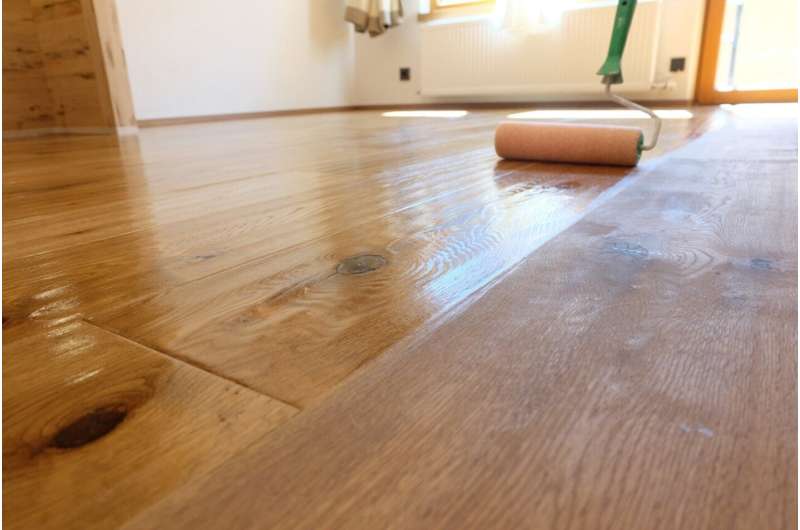This article has been reviewed according to Science X's editorial process and policies. Editors have highlighted the following attributes while ensuring the content's credibility:
fact-checked
trusted source
proofread
Natural sun protection for wood floors and furniture

To keep wood from aging prematurely, it's important to protect it effectively against ultraviolet (UV) radiation. At the same time, people want to retain the look and feel of natural wooden surfaces, but the transparent protective coatings that are currently widely commercially available often contain harmful chemical compounds.
To avoid using these substances, the Fraunhofer Institute for Process Engineering and Packaging IVV and Naturhaus Naturfarben GmbH are working together to develop a formula that provides harmless, transparent and 100% organic UV protection for wood.
Open architecture with glass facades and big windows that let natural light flood into home interiors is very popular—just like the desire for green living in harmony with nature. When it comes to protecting indoor wood surfaces, however, these two needs have been difficult to balance thus far.
Without a coating, UV light ranging from 330 to 380 nanometers in wavelength can interact with wood surfaces, causing discoloration and damage through a process known as photooxidation. But the transparent protective coatings currently available on the market contain chemical additives such as benzophenones, benzotriazoles or phenyltriazine derivatives, all of which are harmful to people's health.
One especially critical point is that these volatile substances can enter the body directly via the respiratory system, for example, during the drying process. Thus far, all bio-based alternatives to protect wood against aging due to sunlight have been colored, so they are opaque.
Proteins for binding, plant extracts for UV protection
This led Fraunhofer IVV and Naturhaus Naturfarben GmbH to the idea of developing a solution for the issue. Tasked with finding suitable plant-based components for a natural wood finish that would protect the material against UV radiation while still leaving the grain visible, Fraunhofer IVV got to work on the ProTann project in 2021.
The scientists decided to explore a completely new research field: "For natural binding in coating systems, we've had great success with using proteins at Fraunhofer IVV for quite some time now," explains Melanie Platzer, a research scientist in the Process Development for Plant Raw Materials department. "One thing that was new for us was combining proteins with secondary plant-based materials that serve as UV protection for a water-based finish."
One of the project's goals was to work out the cross-links created between the proteins and secondary plant-based materials in the finish and ultimately ensure that the substances formed a permanent bond.
A challenging development process
The process of developing the finish took place over several stages. At first, the researchers tested their initial formulation idea, which built on a previous Fraunhofer IVV project that used multiple proteins, such as pea and soy protein.
Platzer comments, "We had a few crucial questions during this phase. Does the coating produced adhere to wood? Does it absorb? And can it be removed so the UV-blocking effect can be measured in the first place?"
Then the project team selected two proteins and added various secondary plant-based substances that offer good protection against UV radiation. The pH presented a challenge, since wood finishes have to fall within a certain range so they do not harm the material.
Adding the plant extracts themselves was also a crucial point for the research team, as it was difficult to foresee in advance how well the various extracts would dissolve, whether they would interact with the proteins, and how the color of the coating created would change over the course of the process.
Which formulation is most suitable?
Over the roughly two-year project term, the scientists tested many combinations. They were also highly successful at working with mixtures of different secondary plant-based substances.
"In the end, we had a lot of good candidates for possible combinations of proteins and additives for the UV protective coating, so we were able to zero in on the question of which formulation makes the most sense in thinking about production—including with an eye to local sourcing and availability of the raw materials used," Platzer says.
"Wherever possible, we include residue from the agriculture and food industry in our development work. That includes things like peels left over from making apple juice, or pomace from wine production."
The options identified are all harmless, with no ill health effects on people or animals from direct contact or breathing fumes.
Further development for protecting wood and more
The model formula selected is now undergoing further development at Naturhaus Naturfarben GmbH. The goal is to adapt the composition so it can be produced on a large scale, ultimately tapping into a new market in the natural wood preservative segment. The water-based formula could then be applied in several coats, with a different natural finish on top as a sealant, to provide lasting protection for wood floors and furniture.
To further develop the many research findings from ProTann and explore their potential, Fraunhofer IVV has already initiated a follow-up project. The UV-blocking combinations of proteins and plant substances could also be used to coat packages or in skincare, for example.
Provided by Fraunhofer-Gesellschaft





















